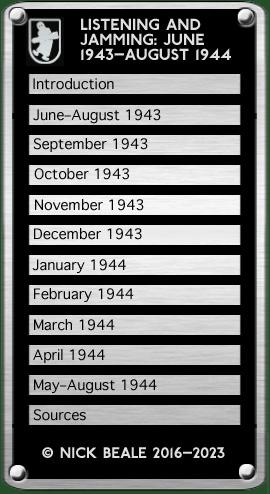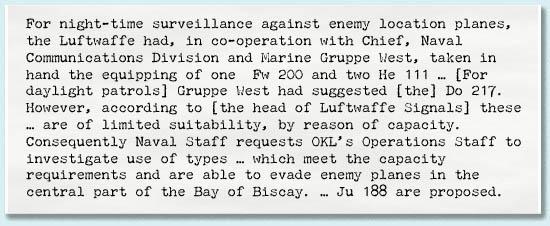 |
||
|
The situation over the Bay of Biscay had been worrying the Kriegsmarine for more than a year. Noting that existing shore-based transmitters had a range of only 65 km, in August 1942 the Chief of Signals Division had concluded that: Jamming transmitters on board submarines are both unsuitable and dangerous. They prevent only range-finding but not direction-finding by aircraft. On the other hand, the use of aircraft of Luftflotte 3 equipped with jamming transmitters over the approach routes is considered very valuable. The German Naval Staff was understandably alarmed by 38 submarine losses during May 1943 (as far as they knew: in fact the figure was 42) in the operational area or on passage through the Bay. To guard against air attack, U-boats were fitted with radar warning receivers such as "Metox" and "Wanze". Nevertheless their signals traffic is full of reports of these devices’ failings and indeed a breakdown was sufficient reason for the boat to return to port. What was more, the Germans had been aware since early March that, “the submarines' radar interception gear can apparently no longer detect locations by enemy planes because they have gone over to new wavelengths” (the first Coastal Command operations with 9 cm ASV Mk. III had taken place that month). Clearly the Kriegsmarine had become seriously alarmed by drastic reverses of the Spring. An investigation at the end of the war by the Combined Intelligence Objectives Sub-Committee (CIOS) noted that a conference had been convened during June 1943 by Konteradmiral Ludwig Stummel, Head of Naval Signals (Marine Nachrichten Dienst or MND) to consider the protection of U-boats against Allied radar, seen as decisive for their future success. Around 400 technical personnel were involved, drawn from a wide variety of organisations. On 4 June, after three more losses attributed to Allied aircraft, the Chief of Staff reported to Hitler that “the Navy’s own measures are exhausted” and that “immediate, concentrated measures on a large scale” were required from the Luftwaffe. A U-boat specially fitted out to detect Allied airborne radars had itself been bombed soon after leaving port and compelled to turn back, no replacement was yet ready but some airborne assistance was in prospect:
Four days later: The accelerating losses this month (38 since 14 April) demonstrate the crisis into which the U-boat war has fallen … The first-rate location devices developed by the enemy, which are specially effective when deployed by [their] aircraft, have no countermeasure on our part and are greatly jeopardising our submarines … Aside from the high figure of nine U-boats lost in Biscay this month, several more boats in this sea area were so badly damaged by aerial bombs, that the majority had to turn back, unable to dive. Given the deficiency in strength of our own air force, the effective combating of enemy aircraft [here] is not to be counted on for the foreseeable future. OKL … informs Naval Staff … of a request to Quartermaster General to convert the next three Ju 188 which are delivered, for use against enemy search planes and to assign them to … Fliegerführer Atlantik for operations in the Bay of Biscay. Here then, were the beginnings of Kommando Rastedter, named for its leader, Obltn. Siegfried Rastedter. The existence of such a unit had been explicitly disclaimed as recently as 21 April. Oberleutnant Lorenz of the II./Ln. Vers. Regt. Köthen asked Sonderkommando Koch for the exact address of Sonderkdo. Rastedter in Luftgau Munich only to receive this answer: There is no such thing as Sonderkommando Rastedter, Oberltn. Rastedter is with Kommando Koch.
As related by captured aircrew from 2./KG 40, an He 111 was based in Bordeaux-Mérignac from June, “engaged in observing Allied wireless traffic” and operating under the direct control of the RLM (Air Ministry). It flew once every two or three days, normally taking off between 0700 and 0800; patrols lasted about eight hours and extended as far as 10º W. The Heinkel’s crew was seconded from KG 40, the pilot being Ofw. Schlittenheim. It also carried a specialist brought in from the Rechlin experimental establishment, presumably to operate the monitoring gear. At the end of July (when the prisoners were shot down) a Ju 88 was also available for monitoring work but had not yet operated although Schlittenheim was said to be hopeful of taking it over or close to England. Two more crews were expected to join the detachment and it was rumoured that a Fw 200 would be employed for long-range listening sorties. The prisoners also passed on German suspicions that the Allies were themselves mounting eavesdropping missions over the Bay. continued on next page …
|
||||


